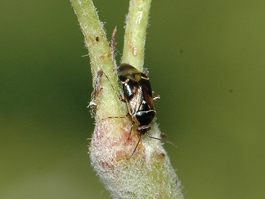By Tianna DuPont, Ricardo Lima Pinto, WSU Extension. April 1, 2024. Reviewed by David Horton, USDA-ARS. Revision to article by Helmut Riedl and Geraldine Warner, originally published 1993.
Deraeocoris brevis (Uhler)
Deraeocoris fasciolus Knight
(Hemiptera: Miridae)
Deraeocoris brevis is an abundant predaceous true bug found in Pacific Northwest apple and pear orchards. Deraeocoris brevis may consume approximately 200 psylla eggs per day and nearly 400 nymphs during its complete lifecycle (Westigard 1973, Booth 1992, Horton 2024).
Hosts
Deraeocoris adults and nymphs prey on many species including spider mites, aphids, leafhoppers, thrips, tingids, and scale insects as well as moth larvae and are considered to be a very important predator of pear psylla (Schuh and Slater 1995, Wheeler 2001, Cassis et al. 2011, Jung SungHoon and Lee SeungHwan 2012).

Life stages
Egg
The egg is elongate and is inserted into plant tissue. Only a small part of the egg is visible. During summer, eggs are most often laid in the leaf midrib.
Nymph
Young nymphs are light pink. Older nymphs are white mottled with gray with visible wingpads and long gray hairs on the thorax and abdomen. Dark areas on the thorax and abdomen give it a spotted appearance. The eyes are dull red.
Adult
Adults (3-6 mm) are shiny black and brown with translucent wing tips.
Life history
Overwintering adults can be found active in orchards starting in late February to early March with complete emergence often by mid-March (Horton 2004). Egglaying begins in April or May, and first-generation nymphs generally appear starting in mid-May (Yakima) to early June (Wenatchee) (Horton et al. 2012, DuPont and Strohm 2020). D. brevis has two to three generations per year in Washington and is present from April to October (DuPont and Strohm 2020).
Monitoring
Monitor D. brevis adults and immatures with beat trays. Hold an 18-inch square tray with a white cloth cover 1 foot below a 0.75 to 1.5-inch diameter limb with an average number of spurs and branches. Tap the limb firmly 3 times with a stiff rubber hose. Count insects jarred from the limb onto the tray. Thirty trays at random intervals across the sampling area is standard for a pear block of 10 to 20 acres. At a threshold of 3 D. brevis immatures per 30 beat trays (0.2 per tray) pear psylla populations in the third generation tend not to increase (DuPont et al. 2023).
Management – Enhancing beneficial populations
Deraeocoris brevis populations can be high in both organic and integrated pest management (IPM) orchards. IPM programs which have supported high Deraeocoris populations have included kaolin clay, lime sulfur, oil, insect growth regulators (pyriproxyfen, buprofezin), essential oils (cinnamon oil, rosemary oil), organic insecticides (azadirachtin, pyrethrin), and certain summer miticides (spirodiclofen, fenbutatin oxide, petroleum oil, bifenazate, clofentezine, hexythiazox) (DuPont and Strohm 2020, DuPont et al. 2021). In pest management programs that include broad spectrum materials (lambda-cyhalothrin, novaluron, chlorpyrifos, thiamethoxam, malathion, esfenvalerate, acetamiprid, abamectin, pyridaben, imidacloprid, spirotetramat) Deraeocoris brevis tend not to be present (DuPont and Strohm 2020, DuPont et al. 2021). D. brevis occur in orchards during the earliest insecticide sprays and thus can be affected by early broad spectrum applications unlike many other predators that emerge later (Horton 2004).
Deraeocoris brevis has a wide host range in extra-orchard habitat. Natural vegetation where they have been found include willow, alder, cottonwood, oak, aspen, poplar, bitterbrush, hawthorn, rose, chokecherry, sagebrush, and ponderosa pine (Booth 1992, Horton and Lewis 2000). It has been proposed that D. brevis is most likely to colonize orchards where woodland or wild habitat is close by.
References
Booth, S. R. 1992. The potential of endemic natural enemies to suppress pear psylla, Cacopsylla pyricola Förster, in the Hood River Valley, Oregon.
Cassis, G., N. Tatarnic, and C. Symonds. 2011. Systematics of the moth larval-feeding genus Kundakimuka Cassis (Hemiptera: Heteroptera: Miridae: Deraeocorinae: Termatophylini). Heteropterus Revista de Entomologia 11: 215-225.
DuPont, S. T., and C. J. Strohm. 2020. Integrated pest management programmes increase natural enemies of pear psylla in Central Washington pear orchards. J. Appl. Entomol. 144: 109-122.
DuPont, S. T., C. Strohm, L. Nottingham, and D. Rendon. 2021. Evaluation of an integrated pest management program for central Washington pear orchards. Biological Control 152.
DuPont, S. T., C. Strohm, C. Kogan, R. Hilton, L. Nottingham, and R. Orpet. 2023. Pear psylla and natural enemy thresholds for successful integrated pest management in pears. Journal of Economic Entomology.
Horton, D. R. 2004. Phenology of emergence from artificial overwintering shelters by some predatory arthropods common in pear orchards of the Pacific Northwest. Journal of Entomological Society of British Columbia 101: 101-108.
Horton, D. R. 2024. Psyllids in Natural Habitats as Alternative Resources for Key Natural Enemies of the Pear Psyllids (Hemiptera: Psylloidea). Insects 15: 37.
Horton, D. R., and T. M. Lewis. 2000. Seasonal distribution of Anthocoris spp. and Deraeocoris brevis in orchard and non orchard habitats of North Central Washington. Annals of the Entomological Society of America 93: 476.
Horton, D. R., E. R. Miliczky, V. P. Jones, C. C. Baker, and T. R. Unruh. 2012. Diversity and phenology of the generalist predator community in apple orchards of Central Washington State (Insecta, Araneae). The Canadian Entomologist 144: 691-710.
Jung SungHoon, J. S., and L. S. Lee SeungHwan. 2012. Molecular phylogeny of the plant bugs (Heteroptera: Miridae) and the evolution of feeding habits.
Schuh, R. T., and J. A. Slater. 1995. True bugs of the world (Hemiptera: Heteroptera): classification and natural history, Cornell UNIVERSITY press.
Westigard, P. H. 1973. The biology of and effect of pesticides on Deraeocoris brevis Piceatus (heteropteraHeteroptera: Miridae). The Canadian Entomologist 105: 1105-1111.
Wheeler, A. G. 2001. Biology of the plant bugs (Hemiptera: Miridae): pests, predators, opportunists, Cornell University Press.



